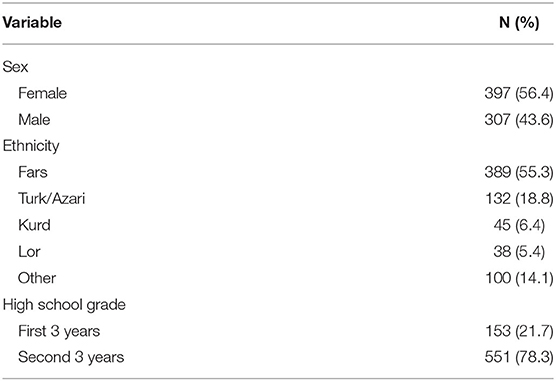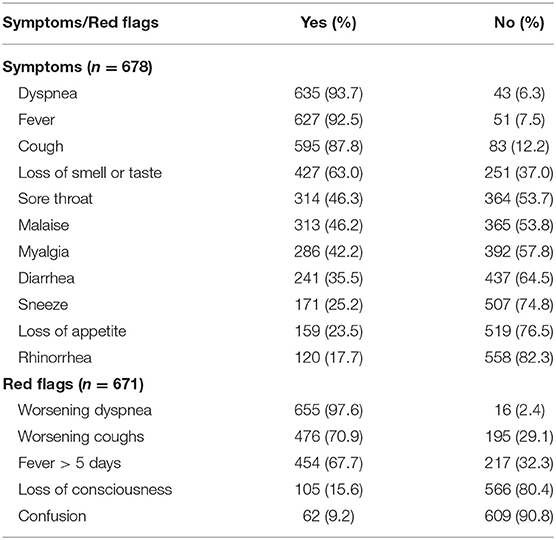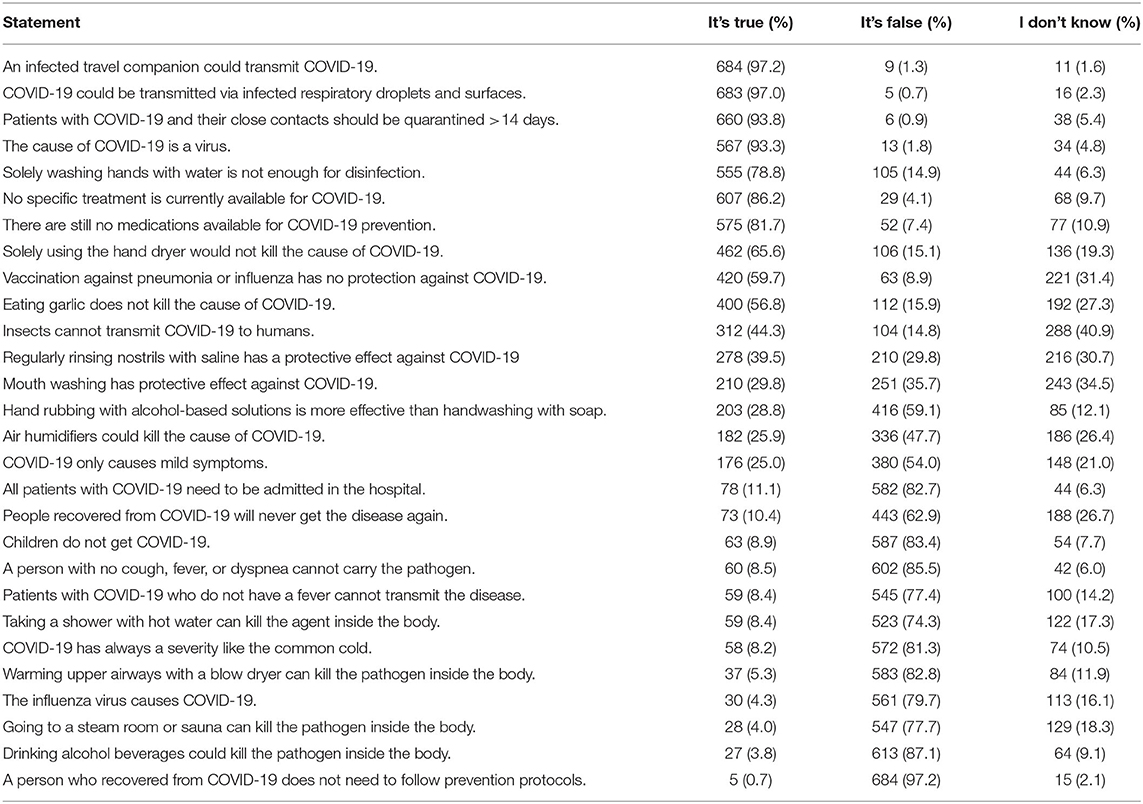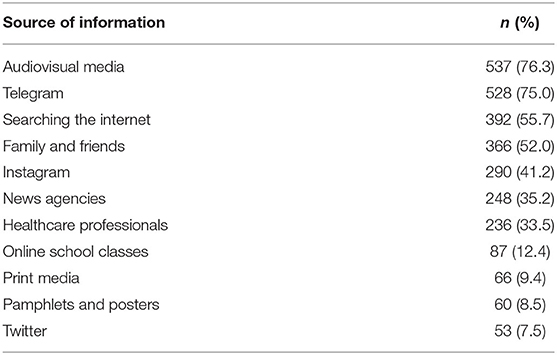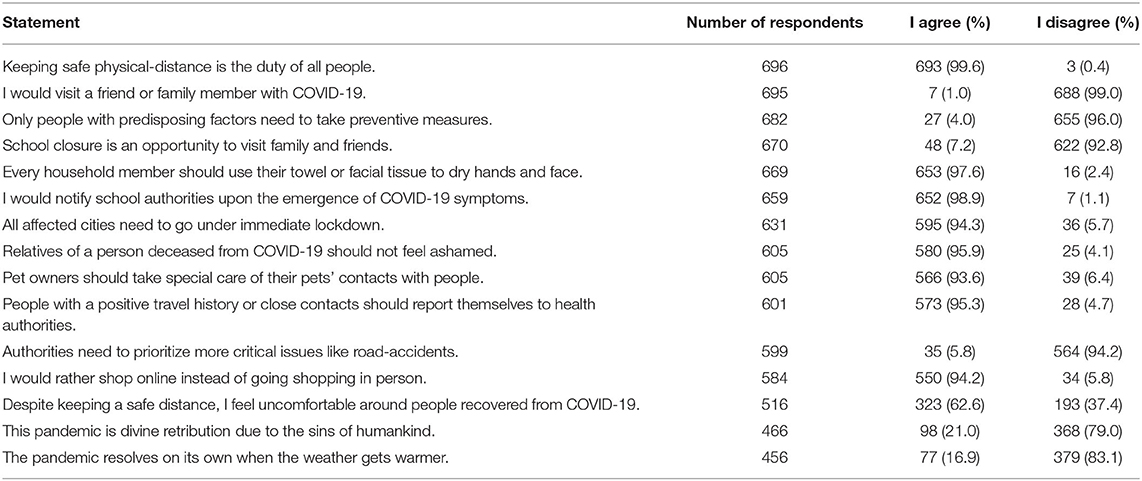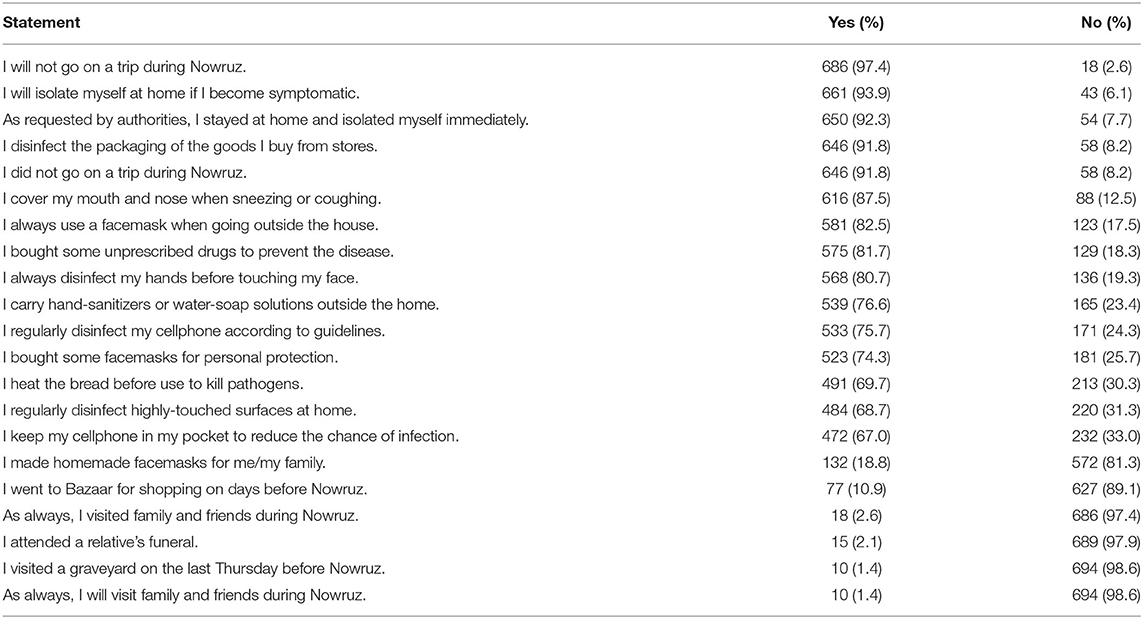- 1Department of Public Health, School of Public Health and Safety and Environmental and Occupational Hazards Control Research Center, Shahid Beheshti University of Medical Sciences, Tehran, Iran
- 2Social Determinants of Health Research Center, Shahid Beheshti University of Medical Sciences, Tehran, Iran
Background: School closures have inevitably deprived students of their traditional source of information. The objective of this study was to determine knowledge, attitudes, and safety practices about COVID-19 among high school students in Iran.
Methods: This study was conducted from March 24th-April 3rd, 2020. Data were collected via an online-parent-administrative questionnaire.
Results: Responses of 704 students were analyzed. Students' mean (SD) knowledge score was 21.5 (4.6) of 30. More than 90% of students knew about the cause of the disease, the routes of transmission, and the most renowned symptoms: dyspnea and cough. Social-and- audiovisual-media were the leading information source. Most students believed that people need to keep safe physical distancing, everyone should isolate themselves upon symptoms onset, people should avoid unnecessary in-person contact with family and friends, and that cities need to go under lockdowns if needed. Students' mean (SD) practice score was 20.2 (2.5) of 24. Most students did not go on a trip, and more than 80% said they would wear facemasks when going outside.
Conclusions: High school students' knowledge and safety practices about COVID-19 were somewhat satisfactory, and their attitudes toward the disease were mainly positive. Nevertheless, some witnessed knowledge gaps, negative attitudes, and unsafe practices in the study highlighted the need for targeted education on the pandemic. Social and mass media's significant role and potential could be utilized to battle misinformation and deliver proper knowledge to young adolescents.
Background
The coronavirus disease 2019 (COVID-19) pandemic has resulted in more than 180 million reported cases and 3.9 million deaths worldwide (1). Most governments had temporarily closed all schools during the first wave of the pandemic to contain the spread of the disease, affecting over 1.5 billion children or 90% of the world's student population (2). Children do not seem to be the direct victims of the adverse health effects of COVID-19. However, the pandemic has the potential to deeply affect young children's development worldwide profoundly, especially their mental and physical well-being, the short-term and long-term repercussions of which are yet to be understood (3, 4).
Schools have been closed due to the COVID-19 pandemic in Iran. School closures inevitably increased the use of online learning platforms (3). The deprivation of students of their traditional source of information has increased their risk to online threats such as the spread of misinformation primarily via social media, which could fuel the potential misunderstandings (5). Accurate information about the disease and the current situation could prevent irrational worries and concerns of children and minimize their anxiety or fear (6). There have been reports of negative stigmatizing attitudes and irresponsible safety practices toward COVID-19. Higher knowledge regarding COVID−19 is associated with a lower likelihood of negative attitudes and potentially dangerous practices (7). Safe health practices and adherence to controlling measures are especially essential and could determine the future course of the pandemic (8).
As an early step toward facilitating the outbreak management and ensuring safe practices, high school students' educational needs need to be addressed to provide training programs via the appropriate media by public health authorities. Therefore, current knowledge, attitudes, and safety practices need to be rapidly investigated, especially in the early days of school closures due to lockdown in Iran. The objective of this study was to determine the knowledge, attitudes, and safety practices of the high school students in Iran about COVID-19 via a rapid online survey administered by students' parents.
Methods
This study was approved by the Ethical Committee of Shahid Beheshti University of Medical Sciences under code IR.SBMU.RETECH.REC.1399.412. Participation was anonymous and upon students' and parental consent.
Setting and Sampling
This study was conducted from March 24th to April 3rd, 2020, in Iran. Data were collected via an online parent-administrative questionnaire in the Google Docs platform. The questionnaire's link was posted on popular social networks in Iran, including Telegram, WhatsApp, Instagram, and Twitter. The questionnaire instructed that parents of high school students read the questions to their children and fill in the questionnaire on their behalf strictly based on their answers. It was emphasized that parents do not change the answers so that we could have a better understanding of their children's educational needs about COVID-19. Participants were high school students, grades 6–12, who lived in the 31 provinces of Iran. Participants who were studying in primary school or were not currently living in Iran were excluded from the study.
Variables and the Questionnaire
Variables included sociodemographic characteristics, knowledge about COVID-19, attitudes toward COVID-19, and safety practices during the pandemic. Sociodemographic characteristics included students' age, sex, ethnicity, high school grade, knowing someone with COVID-19, and the province of residence in Iran.
The questionnaire was in plain Persian and consisted of four main sections: sociodemographic characteristics, knowledge, attitudes, and safety practices about COVID-19.
The knowledge section assessed students' knowledge about cause, transmission, symptoms, red flags, prevention, treatment, sensitive groups, and follow-up for COVID-19; studens' self-evaluation on their level of knowledge, their source of information, and their felt need for further training.
The attitudes section included statements about participants' attitudes toward COVID-19. In response to these statements, participants chose an item from the five-point Likert scale.
The safety practices section assessed students' self-isolation, care-seeking, preventive measures, and going to public places during the pandemic.
A panel of experts evaluated the content validity of the questionnaire. An item discrimination analysis was conducted for each scale to eliminate too tricky or easy items. Factor analysis was performed for factor structure. A separate test-retest over 2 weeks was held for the three scales of the questionnaire. The test-retest correlation for the knowledge scale was 0.89; Kuder-Richardson-20 was used to prevent the overestimation of internal consistency; the coefficient was 0.83. The test-retest correlation for the attitudes scale was 0.91; the coefficient alpha was 0.87. The test-retest correlation for the practice scale was 0.87; the coefficient alpha was 0.88. The pilot survey was conducted on fifty female and fifty male students. The English and Persian versions of the questionnaire are available in Supplementary Table 1.
Data Analysis
One point was awarded to each correct answer to score students' knowledge about COVID-19. To analyze students' attitudes, “I strongly agree” and “I agree” were considered as “I agree”; and “I strongly disagree” and “I disagree” were considered as “I disagree.” To analyze students' safety practices, one point was awarded to taking each right measure or not taking each wrong measure. The 95% confidence interval (95% CI) was reported for the key proportions using the exact binomial distribution. Categorical variables were analyzed by the Chi-Square test. For analyzing the differences among means of two groups and three groups or more, independent-sample t-test and one-way analysis of variance (ANOVA) test were used. Statistical analyses were performed using IBM SPSS Statistics 21. A probability level of <0.05 was considered significant. Figures were designed by Tableau Desktop 2018 (Washington, USA).
Results
The responses of 704 students were analyzed. The mean (SD) age of students was 16.5 (1.7) [range = 10–19, being 16.6 (1.7) among girls, and 16.4 (1.6) among boys]. As many as 371 (52.7%) participants reported they knew someone with COVID-19. Other sociodemographic characteristics of students are presented in Table 1.
Knowledge
Symptoms and Red Flags of COVID-19
More than 90% of students recognized that COVID-19 could present itself with dyspnea and cough. Although some 98% knew that worsening dyspnea could be a red flag, some 68% considered persistent fever dangerous. As many as 26 (3.8%) and 33 (4.6%) reported they did not know what the symptoms of and red flags of severe disease were, respectively (Table 2, Supplementary Figures 1, 2).
General Knowledge About COVID-19
More than 90% of students correctly recognized the cause of COVID-19, its routes of transmission, and the necessity of self-isolation (Table 3). The mean (SD) knowledge score was 21.5 (4.6), range = 1–30, which is 71.6% of 30. No significant differences were observed between students' knowledge scores and their age, sex, province, knowing someone with COVID-19, having a household member with COVID-19, having the disease, or having a family member passing away from COVID-19.
Students' Self-Evaluation on Their Level of Knowledge About COVID-19
As many as 203 (28.8) students considered their level of knowledge sufficient, 450 (63.9) fair, and 51 (7.2) insufficient. Subsequently, when asked about their felt need for further training, 429 (60.9) said yes. As indicated in Table 4, audiovisual media and Telegram were the leading sources of information about COVID-19 among students, and online school classes had less contribution in this regard (Supplementary Figure 3).
Attitudes
When asked about the reaction if they had COVID-19, 644 (91.5%) reported seeing a doctor in case symptoms get worse, 614 (87.2%) self-isolation at home, while 14 (2.0%) continuing daily life.
As many as 165 (23.4%) said, it is very highly likely that COVID-19 is made for bioterrorism, 190 (27.0%) high, 203 (28.8%) fair, 80 (11.4%) low, and 66 (9.4%) very low.
About the students' evaluation on how dangerous the current situation is, 308 (43.8%) said very high, 299 (42.5%) high, 84 (11.9%) fair, 8 (1.1%) low, and 5 (0.7%) very low.
While 610 (86.6%) students thought that nations would finally defeat the disease, 94 (13.4%) said COVID-19 could not be defeated.
In response to a question asking how long it would take to control this pandemic, 7 (1.0%) said less than a month, 131 (18.6%) 1–3 months, 218 (31.0%) 3–6 months, 119 (16.9%) 6–9 months, 106 (15.1%) 9–12 months, 106 (15.1) more than a year, and 17 (2.3%) had no idea.
Most students had positive attitudes toward COVID-19. They believed that people need to keep safe physical distancing, everyone should isolate themselves upon symptoms onset, and that cities need to go under lockdowns if needed. However, more than 20% thought the pandemic is divine retribution for the sins of humankind, and they were most uncomfortable to be around a person who has recently recovered from COVID-19 (Table 5).
Safety Practices
Self-Isolation and Care-Seeking
Among students, 3 (0.4) reported they had become COVID-19 positive, 603 (85.7) reported they did not get the disease, and 98 (13.9) reported they had some symptoms but took no measures.
Preventive Measures for COVID-19
When asked about what they did to prevent COVID-19, 644 (91.5) students reported staying at home, 638 (90.6) practicing hand hygiene, 470 (66.8) keeping safe physical distance, 517 (73.4) wearing gloves, and 512 (72.7) wearing a facemask, 238 (33.8) taking vitamin supplements, 164 (23.3) drinking herbal tea, 13 (1.8) taking Imam-Kazem-drug, 5 (0.7) performing wet cupping.
Wearing Facemasks
Among 446 students, 177 (39.7) reported they wear surgical masks, 148 (33.2) cloth masks, 154 (34.5) N95 masks, and 57 (12.8) homemade masks. However, 50 (11.2) respondents reported they did not wear masks. The mean (SD) duration of waring each mask was 5.3 (8.7) h, median (IQR) = 3.0 (2–5).
Leaving the House
The mean (SD) times of going outside the house during the past week were 1.8 (3.2), median (IQR) = 1 (0–2). About the reason to leave the house, 269 (38.2) reported grocery shopping, 44 (6.3) shopping items other than groceries, 69 (9.8) visiting family and friends, 67 (9.5) sightseeing, and 19 (2.7) going to healthcare facilities. As many as 254 (36.1) reported they did not leave the house. Among male students, 78 (25.4%) stated they did not leave the house during the pandemic, which was 176 (44.3%) among female participants, p < 0.001.
Handwashing
The mean (SD) times of daily handwashing with water and soap among students was 9.0 (9.9), median (IQR) = 6 (4–10). The mean (SD) duration of handwashing was 23.4 (16.8) seconds, median (IQR) = 20 (15–30).
The mean (SD) times of daily hand-rub with alcohol-based hand sanitizers among students was 3.8 (9.3), median (IQR) = 2 (0–4). The mean (SD) duration of hand-rub was 9.2 (9.9) seconds, median (IQR) = 10 (0–15).
General Safety Practices About COVID-19
The mean (SD) score for general safety practices about COVID-19 was 20.2 (2.5), range = 4–24, which is 84.1% of 24 (Table 6). No significant differences were observed between practice scores of students and their age, sex, province of residence, whether they knew someone with COVID-19, whether they had a household member with COVID-19, whether they caught the disease, or whether a family member had passed away from COVID-19.
Discussion
Students' knowledge and safety practices about COVID-19 were somewhat adequate, and their attitudes toward the disease were positive. Most students knew that dyspnea and cough could be symptoms of COVID-19. In comparison, only half of the young adults in Karachi in a study recognized fever as a disease symptom (9). Almost all students recognized respiratory droplets as a transmission route, similar to a study among senior pharmacy students in Egypt (10). The majority of students said there were no medications available for the disease at the time, which was higher than the undergraduate students in a study in Italy (11). There were misbeliefs about COVID-19 among students. Although hand hygiene with soap and water is strongly recommended for disease prevention (12), some students said that washing hands without soap is sufficient for disinfection. Furthermore, some said that using hand dryers could effectively kill the pathogen, which is considered a myth (13).
Some 40% of students were unsure if COVID-19 could be transmitted via insects. There was no evidence of COVID-19 transmission by blood-feeding arthropods such as mosquitoes at the study time (14). However, it is now known that SARS-CoV-2 fails to infect or replicate in mosquitoes (15). The witnessed level of uncertainty regarding transmission routes calls for education campaigns by education and healthcare authorities.
While Telegram and the audiovisual media were the sources of information for most students, only 12% mentioned online school classes as their source of information about COVID-19. No studies were available which investigated the usage pattern of social media among Iranian adolescents. Our results illustrated the lack of school engagement in increasing students' awareness regarding different aspects of COVID-19. It is worth mentioning that the lockdown could have provided a more significant opportunity to watch television and surf the internet while staying at home (16). Mass media are valuable resources for efficiently forming people's knowledge and attitudes, improving their risk perception, and adequately informing people about risks and precautions (17). Although social media has played a significant role in information dissemination, its contribution to disseminating misinformation is noticeable (18). Social media provides a unique platform for engagement with experts. However, the lack of scientific peer review can contribute to mass hysteria rather than alleviating it. Since filtering the knowledge from the misinformation is hugely challenging in social media, the focus must be on reliable sources which avoid personal opinion or conjecture (19). This calls for extensive collaboration among public health authorities and the media outlets to provide and deliver specific health information to all the sectors of the society, especially children and young adolescents whose level of contribution to COVID-19 transmission on a community level has remained controversial (20).
There were no significant differences among students' knowledge score and their province of residence. This could suggest that the information origin of the popular media was the same, led by the national audiovisual media. Although the gender of the students was not a determinant of their level of knowledge, there are studies where women were more knowledgeable about COVID-19 (7, 11). No significant differences were found in the knowledge scores of students of various ethnicities. On the contrary, a study in the United States reported significant differences between white people and other ethnicities (21).
Most students believed that nations would finally defeat the disease, which is higher than a study among senior pharmacy students in Egypt (10) and similar to a study among the public in Malaysia (22). The majority of children expected that the pandemic would be controlled within a year, highlighting their hopes and belief in the scientific community and healthcare authorities. In the meantime, most students believed that people need to follow safe practices as suggested by healthcare authorities.
The pandemic unlocks some potentials of currently available technology and thus transforms people's behavior (23). Consumers are adapting to movement restrictions and are adopting newer technologies to facilitate work. More and more people are choosing online shopping to avoid unnecessary transport and contact with others. In our study, 94% of students reported that they would rather shop online instead of shopping in person.
Some 36% of students said they did not leave their houses during the preceding week, which is significant, especially considering that the early days of movement restrictions coincided with the holidays for the Persian new year, Nowruz, which are at least 2 weeks. Iranians have rituals before and during Nowruz. Before Nowruz, they go shopping for new clothes, shoes, sweets, and nuts, which are crucial for children and young adolescents. They also visit graveyards for deceased beloved ones on the last Thursday before Nowruz. During the holidays, Iranians visit family and friends or go on trips. However, some 90% of students reported that they did not go to the Bazaar before Nowruz and did not go on trips during the holidays. Students had a relatively safe hygiene practice. Only 11% of students said they did not wear masks while going outside, which is much lower than the 50% among senior pharmacy students in a study in Egypt (10) or the public in Malaysia (22). Nevertheless, some students followed traditional methods to prevent the disease. This could raise concerns, as the use of unapproved medications could result in unknown consequences (24).
Strengths and Limitations
This is a rapid online survey to assess the knowledge, attitudes, and safety practices of high school students in Iran about COVID-19. Although in the recent infectious outbreaks, some concerns about Iranian students' knowledge, attitudes, and safety practices were raised (25), a study that specifically considers high school students has not been conducted in previous infectious outbreaks in Iran. The strengths are its rather large sample and data gathering in the early days of the outbreak in Iran. Findings could empower education and public health authorities better to understand the current educational needs of high school students to be addressed. We realize the limitations of the study. Due to the complexity of some questions in the questionnaire of the present study, only high school students were included in the study. Nevertheless, the knowledge, attitudes, and safety practices of primary school students need to be investigated, considering that they are also quite influenced by social media (26). The administration of the study questionnaire via parents of the students could result in some impairments in the reflection of truths. Although we had explicitly asked parents not to change their children's answers, such voluntary measures are not guaranteed. Since there was no representative online platform to connect researchers to people in Iran, we decided to conduct this study in the Google Forms platform. The penetration rate of the Internet in Iran is high. However, some groups, especially those in rural areas, might not have access to the platform.
Conclusions
High school students' knowledge and safety practices about COVID-19 were somewhat satisfactory, and their attitudes toward the disease were mainly positive. Nevertheless, some witnessed knowledge gaps, negative attitudes, and unsafe practices in the study highlighted the need for targeted education on the pandemic. The significant role and potential of social and mass media could be utilized to battle misinformation and deliver proper knowledge to young adolescents.
Data Availability Statement
The data that support the findings of this study are available from Social Determinants of Health Research Center, Shahid Beheshti University of Medical Sciences, Tehran, Iran but restrictions apply to the availability of these data, which were used under license for the current study, and so are not publicly available. Data are however available from the authors upon reasonable request and with permission of Shahid Beheshti University of Medical Sciences, Tehran, Iran.
Ethics Statement
This study was approved by the Ethical Committee of Shahid Beheshti University of Medical Sciences under code IR.SBMU.RETECH.REC.1399.412. Participation was anonymous and upon the participant's own decision and parental consent. Written informed consent to participate in this study was provided by the participants' legal guardian/next of kin.
Author Contributions
A-AK, HH, and MA-K: conceptualization. A-AK, MA-K, and M-RM: data collection. MA-K and M-RM: data analysis. HH and MA-K: writing—original draft. A-AK, MA-K, and HH: writing—review and editing. A-AK: resources and supervision. All authors have read and approved the manuscript prior to submission.
Funding
This study was supported by Social Determinants of Health Research Center, Shahid Beheshti University of Medical Sciences under code 22975. The funding body was not in any ways involved in the design of the study and collection, analysis, and interpretation of data and in writing the manuscript.
Conflict of Interest
The authors declare that the research was conducted in the absence of any commercial or financial relationships that could be construed as a potential conflict of interest.
Publisher's Note
All claims expressed in this article are solely those of the authors and do not necessarily represent those of their affiliated organizations, or those of the publisher, the editors and the reviewers. Any product that may be evaluated in this article, or claim that may be made by its manufacturer, is not guaranteed or endorsed by the publisher.
Acknowledgments
The authors would like to thank all people who participated in the study. We appreciate the invaluable contribution of medical students Javad Khanali, Ali Akhoondi, and Mohammad-Mahdi Salar-Abedi. This study was the thesis for the Master of Public Health (MPH) of Mohsen Abbasi-Kangevari.
Supplementary Material
The Supplementary Material for this article can be found online at: https://www.frontiersin.org/articles/10.3389/fpubh.2021.680514/full#supplementary-material
Supplementary Figure 1. Students' knowledge on symptoms of COVID-19.
Supplementary Figure 2. Students' knowledge on red-flags of severe disease.
Supplementary Figure 3. Students' sources of information about COVID-19.
Supplementary Table 1. The English and Persian versions of the study questionnaire.
Abbreviations
COVID-19, The coronavirus disease 2019; ANOVA, One-way analysis of variance; SD, Standard deviation.
References
1. Dong E, Du H, Gardner L. An interactive web-based dashboard to track COVID-19 in real time. Lancet Infect Dis. (2020) 20:533–4. doi: 10.1016/S1473-3099(20)30120-1
2. UNESCO. School closures caused by Coronavirus (Covid-19). Available online at: https://en.unesco.org/covid19/educationresponse (accessed June 29, 2020).
3. Yoshikawa H, Wuermli AJ, Britto PR, Dreyer B, Leckman JF, Lye SJ, et al. Effects of the global COVID-19 pandemic on early childhood development: short- and long-term risks and mitigating program and policy actions. J Pediatr. (2020) 223:188–93. doi: 10.1016/j.jpeds.2020.05.020
4. Shonkoff JP, Garner AS. The lifelong effects of early childhood adversity and toxic stress. Pediatrics. (2012) 129:e232–46. doi: 10.1542/peds.2011-2663
5. Zarocostas J. How to fight an infodemic. Lancet. (2020) 395:676. doi: 10.1016/S0140-6736(20)30461-X
6. Dalton L, Rapa E, Stein A. Protecting the psychological health of children through effective communication about COVID-19. Lancet Child Adolesc Heal. (2020) 4:346–7. doi: 10.1016/S2352-4642(20)30097-3
7. Zhong BL, Luo W, Li HM, Zhang QQ, Liu XG, Li WT, et al. Knowledge, attitudes, and practices towards COVID-19 among Chinese residents during the rapid rise period of the COVID-19 outbreak: a quick online cross-sectional survey. Int J Biol Sci. (2020) 16:1745–52. doi: 10.7150/ijbs.45221
8. Paakkari L, Okan O. COVID-19: health literacy is an underestimated problem. Lancet Public Heal. (2020) 5:e249–50. doi: 10.1016/S2468-2667(20)30086-4
9. Mubeen SM, Kamal S, Kamal S, Balkhi F. Knowledge and awareness regarding spread and prevention of COVID-19 among the young adults of Karachi. J Pak Med Assoc. (2020) 70(Suppl. 3):S169–74. doi: 10.5455/JPMA.40
10. Hamza MS, Badary OA, Elmazar MM. Cross-sectional study on awareness and knowledge of COVID-19 among senior pharmacy students. J Community Health. (2020) 46:1–8. doi: 10.21203/rs.3.rs-33352/v1
11. Gallè F, Sabella EA, Da Molin G, De Giglio O, Caggiano G, Di Onofrio V, et al. Understanding knowledge and behaviors related to CoViD-19 epidemic in Italian undergraduate students: the EPICO study. Int J Environ Res Public Health. (2020) 17:3481. doi: 10.3390/ijerph17103481
12. Adhikari SP, Meng S, Wu Y-J, Mao Y-P, Ye R-X, Wang Q-Z, et al. Epidemiology, causes, clinical manifestation and diagnosis, prevention and control of coronavirus disease (COVID-19) during the early outbreak period: a scoping review. Infect Dis Poverty. (2020) 9:29. doi: 10.1186/s40249-020-00646-x
13. Shankar A, Saini D, Roy S, Mosavi Jarrahi A, Chakraborty A, Bharti SJ, et al. Cancer care delivery challenges amidst coronavirus disease – 19 (COVID-19) outbreak: specific precautions for cancer patients and cancer care providers to prevent spread. Asian Pacific J Cancer Prev. (2020) 21:569–73. doi: 10.31557/APJCP.2020.21.3.569
14. Eslami H, Jalili M. The role of environmental factors to transmission of SARS-CoV-2 (COVID-19). AMB Express. (2020) 10:92. doi: 10.1186/s13568-020-01028-0
15. Huang YJS, Vanlandingham DL, Bilyeu AN, Sharp HM, Hettenbach SM, Higgs S. SARS-CoV-2 failure to infect or replicate in mosquitoes: an extreme challenge. Sci Rep. (2020) 10:11915. doi: 10.1038/s41598-020-68882-7
16. Carducci A, Fiore M, Azara A, Bonaccorsi G, Bortoletto M, Caggiano G, et al. Environment and health: risk perception and its determinants among Italian university students. Sci Total Environ. (2019) 691:1162–72. doi: 10.1016/j.scitotenv.2019.07.201
17. Brug J, Aro AR, Oenema A, de Zwart O, Richardus JH, Bishop GD. SARS risk perception, knowledge, precautions, and information sources, the Netherlands. Emerg Infect Dis. (2004) 10:1486–9. doi: 10.3201/eid1008.040283
18. Merchant RM, Lurie N. Social media and emergency preparedness in response to novel coronavirus. JAMA. (2020) 323:2011–2. doi: 10.1001/jama.2020.4469
19. Rochwerg B, Parke R, Murthy S, Fernando SM, Leigh JP, Marshall J, et al. Misinformation during the coronavirus disease 2019 outbreak: how knowledge emerges from noise. Crit care Explor. (2020) 2:e0098. doi: 10.1097/CCE.0000000000000098
20. Viner RM, Mytton OT, Bonell C, Melendez-Torres GJ, Ward J, Hudson L, et al. Susceptibility to SARS-CoV-2 infection among children and adolescents compared with adults: a systematic review and meta-analysis. JAMA Pediatr. (2021) 175:143–56. doi: 10.1001/jamapediatrics.2020.4573
21. Alobuia WM, Dalva-Baird NP, Forrester JD, Bendavid E, Bhattacharya J, Kebebew E. Racial disparities in knowledge, attitudes and practices related to COVID-19 in the USA. J Public Health (Bangkok). (2020) 42:470–8. doi: 10.1093/pubmed/fdaa069
22. Azlan AA, Hamzah MR, Sern TJ, Ayub SH, Mohamad E. Public knowledge, attitudes and practices towards COVID-19: a cross-sectional study in Malaysia. PLoS ONE. (2020) 15:e0233668. doi: 10.1371/journal.pone.0233668
23. Sheth J. Impact of Covid-19 on consumer behavior: will the old habits return or die? J Bus Res. (2020) 117:280–3. doi: 10.1016/j.jbusres.2020.05.059
24. Yang Y. Use of herbal drugs to treat COVID-19 should be with caution. Lancet. (2020) 395:1689–90. doi: 10.1016/S0140-6736(20)31143-0
25. Holakouie-Naieni K, Ahmadvand A, Raza O, Assan A, Elduma AH, Jammeh A, et al. Assessing the knowledge, attitudes, and practices of students regarding ebola virus disease outbreak. Iran J Public Health. (2015) 44:1670–6.
Keywords: attitudes, coronavirus, knowledge, perceptions, safety practices, SARS-CoV-2, COVID-19
Citation: Hatami H, Abbasi-Kangevari M, Malekpour M-R and Kolahi A-A (2021) Knowledge, Attitudes, and Safety Practices About COVID-19 Among High School Students in Iran During the First Wave of the Pandemic. Front. Public Health 9:680514. doi: 10.3389/fpubh.2021.680514
Received: 14 March 2021; Accepted: 30 June 2021;
Published: 04 August 2021.
Edited by:
Zisis Kozlakidis, International Agency For Research On Cancer (IARC), FranceReviewed by:
Jagadeesh Menon, Dr. Rela Institute & Medical Centre, IndiaHuda Eid, The University of Jordan, Jordan
Copyright © 2021 Hatami, Abbasi-Kangevari, Malekpour and Kolahi. This is an open-access article distributed under the terms of the Creative Commons Attribution License (CC BY). The use, distribution or reproduction in other forums is permitted, provided the original author(s) and the copyright owner(s) are credited and that the original publication in this journal is cited, in accordance with accepted academic practice. No use, distribution or reproduction is permitted which does not comply with these terms.
*Correspondence: Ali-Asghar Kolahi, YS5rb2xhaGlAc2JtdS5hYy5pcg==; Mohsen Abbasi-Kangevari, bW9oc2VuLmFiYmFzaUBzYm11LmFjLmly
 Hossein Hatami1
Hossein Hatami1 Mohsen Abbasi-Kangevari
Mohsen Abbasi-Kangevari Mohammad-Reza Malekpour
Mohammad-Reza Malekpour Ali-Asghar Kolahi
Ali-Asghar Kolahi